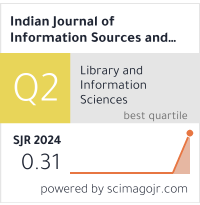Metric Analysis of Literature in the Field of Infertility
DOI:
https://doi.org/10.51983/ijiss-2022.12.1.3099Keywords:
Infertility, Metrics, Bradford's Law, Degree of CollaborationAbstract
This paper offers a metric find out of literature in the field of Infertility. The publications distributed span of the year 2011 to 2020 was considered. The distributions in the field of Infertility which is shrouded in MEDLINE information included in the PubMed were considered. In general, it is seen that from the year 2011 onward there is a continuous make greater in research on Infertility without few years. A sum of 43229 publications on ‘Infertility’ is concealed in the MEDLINE data. It is observed that the most variety of 5999 publications was once posted throughout 2020. It used to be discovered that 45.95% are journal articles, 22.73% are Research Support, Non-U.S. Govt and 16.23% is Review. A total of 25 core journals grouped in zone-1 posted 6654 journal articles accounting for one third of the complete output. A whole of 237 journals has been recognized as core journals in the subject of Infertility. A complete of 6.46% of the distributions has been via single author distributions. A total of 92.98% of distributions is composed via multi-authors. A small rate (0.55%) represents anonymous initiation and the normal Degree of Collaboration showed up at 0.94 in the field of Infertility literature.
References
Retrieved from https://en.wikipedia.org/wiki/Infertility.
Heine M. H. (1998). Bradford ranking conventions and their application to a growing literature. Journal of Documentation, 54(3), 303-331.
Feicheng, M., & Rui, C. (1999). Study on the laws of scattering distribution analysis from document level to content level (II): Scattering distribution of document unit by Frequency-rank analysis of Bradford’s Law. Journal of the China Society for Scientific and Technical Information, 18(2), 171-182.
Bogaert, J., Rousseau, R., & Vanhecke P. (2000). Percolation as a model for informetric distributions: Fragment size distribution characterized by Bradford Curves. Scientometrics, 47(2), 195-206.
Steven, S. R. (2000). Mapping the literature of cytotechnology. Bulletin of Medical Library Association, 88(2), 172-77.
Walcott, B. M. (1999). Mapping the literature of diagnostic medical sonography. Bulletin of Medical Library Association, 87(3), 287-91.
Burnham, J. E. (1997). Mapping the literature of respiratory therapy. Bulletin of Medical Library Association, 85(3), 293-96.
Slater, L. G. (1997). Mapping the literature of speech-language pathology. Bulletin of Medical Library Association, 85(3), 297-02.
Burnham, J. E. (1997). Mapping the literature of radiologic technology. Bulletin of Medical Library Association, 85(3), 289-92.
Delwiche, F. A. (2003). Mapping the literature of clinical laboratory science. Bulletin of Medical Library Association, 91(3), 303-10.
Schloman, B. E. (1997). Mapping the literature of allied health: project overview. Bulletin of Medical Library Association, 85(3), 271-77.
Ramesh Kundra et al., (1999). Behavior of Bradford’s Law towards citation data on Indian Medical Journal. In: International Conference on Scientometrics and Informetrics Proceedings, 580. Colima; Mexico.
Patra, S. K., & Prakash Chand. (2007). HIV/AIDS Research in India: A bibliometric study. Library and Information Science Research, 29, 124-134.
Ramakrishnan, J., & Thavamani, K. (2012). Bibliometric Analysis of the Literature of Hepatitis C. In: Role of Medical Libraries in Global Health Initiatives MLAI 2012. National Convention, North Eastern Indira Gandhi Regional Institute of Health & Medical Sciences; Shilog (India).
Farahat, Hashem. (2002). Authorship patterns in agriculture sciences in Egypt. Scientometrics, 55(2), 157-170.
Karisiddappa, C. R., Gupta, B. M., & Kumar, S. (2002). Scientific productivity of authors in theoretical population genetics. Scientometrics, 53(1), 73-93.
Shirabe, M., & Tomizawa, H. (2002). Likelihood of overseas access to international co-authorships. Scientometrics, 53(1), 123-129.
Dutt, Bharvi, Garg, K. C., & Bali, Anita. (2003). Scientometrics of the International Journal Scientometrics. Scientometrics, 56, 81-93.
Ramakrishnan, J., Ravisankar, G., and Thavamani, K. (2019). Bibliometric Analysis of Authorship Pattern in Swine Flu Diseases. Indian Jour. Inf Lib. & Soc., 32(3-4), 206-20.
Retrieved from https://pubmed.ncbi.nlm.nih.gov/?term=infertility& filter=years.2011-2020.
Bradford, S. C. (1948). Documentation. Crosby, Lockwood: London.
Subramanyam, K. (1993). Bibliometric Studies of Research Collaboration: A Review. Journal of Information Science, 6, 33-38.
Downloads
Published
How to Cite
Issue
Section
License
Copyright (c) 2022 The Research Publication

This work is licensed under a Creative Commons Attribution-NonCommercial-NoDerivatives 4.0 International License.









